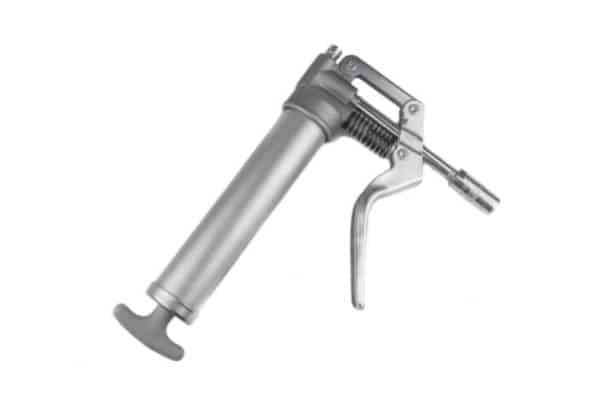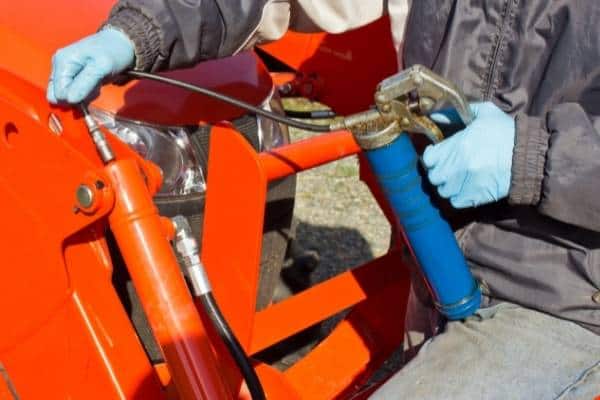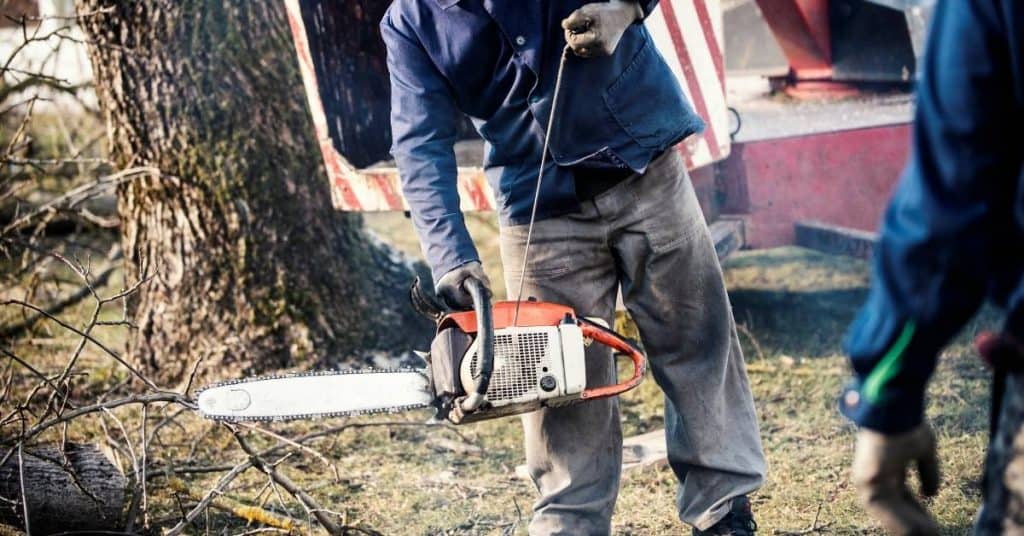Grease guns are designed to be used by professionals. However, the average homeowner has no idea how to load a grease gun properly and has messy results.
We put together a guide on how to load and operate a grease gun properly so that you don’t waste any grease or hurt yourself in the process. You’ll have the perfect amount of grease in your barrel for easy application on your next project.
Follow these simple steps, and you’ll be greasing like an expert in no time!
About the Grease Gun
Grease Guns are used when you need to add a viscous lubricant, or grease, to the moving parts of a machine.
Grease guns come in a variety of shapes and sizes with different options. Depending on what you need to do, a style will fit your needs, like cartridge loaders for quick and easy applications or reservoir-style for long-term filling without replacing cartridges.
How Does a Grease Gun Work?
Grease guns are composed of three main parts: the barrel, which holds the cartridge or reservoir, a plunger, and a pump. Each has its own use in loading and applying your grease gun.

It is important to learn where the fittings and moving parts are on all your machines and equipment. This will ensure you are applying grease to the correct places. Also, make sure you know what type of grease is for each application. Using the wrong type of grease can run your machine or cause complications.
How to Load a Grease Gun
Loading a grease gun sounds like an easy enough task. Still, if done improperly, the results are less than desirable, resulting in wasted materials or even bodily harm from pressing too hard. Follow these steps, and you’ll be loaded in no time.
How to Load A Grease Gun with a Cartridge
Step 1: Get Your Grease Ready
Before loading your grease gun, ensure that you have the correct cartridge ready to go. The wrong grease application could cause damage to your machine, so make sure you are using the right grease. Don’t forget to put on some gloves and have a rag nearby.
Step 2: Pull Back the Plunger
Pull the plunger out until you it is fully withdrawn. There may be a groove that the plunger slides into once it is pulled out fully to keep the plunger from springing back. Pull out fully and then twist or slide the plunger into the groove.
Step 3: Unscrew the Barrel Head with the Pump
Unscrew the cartridge cap on the side with the nozzle. The easiest way is to hold onto the cap and pump and rotate the cartridge barrel until completely unscrewed.
Step 4: Remove Empty Cartridge
Remove the empty cartridge from the barrel. If it doesn’t slide right out, you can release the plunger in a little to help it push out the cartridge. Be careful because it could potentially shoot it out. Throw away an empty cartridge.
Step 5: Put in New Cartridge of Grease
Wipe off the threads on the barrel with your rag if there is any grease on them. Open the new cartridge by taking off the plastic or cardboard lid. Slide the new cartridge in the barrel open side first. Push it in completely. The end showing at the top of the barrel should have a metal pop-top. Remove the pop-top and dispose of it.
Step 6: Replace Cap onto the Barrel
Screw the barrel back into the cap with the pump hand and nozzle. Don’t tighten completely. You want to make sure any air bubbles can escape. Once you hand tighten it, loosen about a half of the turn to make sure it isn’t too tight.
Step 7: Release Air Bubbles and Prime Nozzle
Push the plunger back into the grease gun barrel. Pump the handle a few times until grease starts coming out. If your grease gun has an air bleeder valve, push it down to release any air. Once the air is completely released, tighten the cap onto the assembly. Pump handle to make sure grease is still coming out. Wipe off any grease from the nozzle, and you are ready to go!
How to Load a Grease Gun Without a Cartridge
Grease guns are designed to be used with cartridges. However, bulk filling can be beneficial if you are using greasing a lot of things. It is more cost-effective and reduces the number of cartridges you are using and needing to dispose of.
Suction Method
This method is not used as much anymore due to the potential of contamination. It can be used as a last resort bulk filling method.
Step 1: Unscrew the Cap with the nozzle and cap.
Step 2: Wipe off any debris or grease from the head of the grease gun assembly and insert it into the grease barrel.
Step 3: Pull back the plunger, so it sucks up the grease into the reservoir. Suppose an air-bubble forms push out the grease, and start over.
Step 4: Wipe off any excess grease and replace the cap, not completely tightening. Push the plunger back in and push the air bleeder if you have the air bleeder valve. Fully tighten the cap.
Bulk Filling Pump
A bulk filling pump is the most efficient way to fill up from a bulk barrel of grease. It goes directly on the barrel and reduces any contamination from occurring.
Step 1: Pull the plunger all the way out until it locks into place on the bottom cap.
Step 2: Insert the filling nipple on the cap of your gun into the filling fitting on the bulk pump. Most grease guns these days have these nipples already. You can also buy one separately.
Step 3: Pump the barrel to begin filling your reservoir. Once the plunger starts to move out of the groove, it is at filling capacity. Remove from filling fitting and push the plunger back in. Wipe away any excess grease.
Types of Grease Guns
The first step in learning how to use a grease gun is learning your options. Many homeowners find the cartridge loader style of grease gun attractive because it’s easy to use, requires little maintenance, and is fast. Another common grease gun is the reservoir-style.
Here are some other types of grease guns:
- manual grease gun
- pneumatic grease gun
- electric grease gun
- battery-powered grease gun
Cartridge Loaders vs Reservoir-Style
There are two main styles for grease guns — cartridge loaders and reservoir style. The main difference between these options is that each can be used in different applications.
Cartridge loaders are used when only a small amount of grease is required, like lubricating a bike chain or gasket. The cartridge holds the grease and can be loaded quickly by screwing it directly into the barrel. No pumping is needed, which makes them easy and fast to use.
Reservoir-style grease guns are best used when more than one ounce of grease is required, like lawnmower blades and other parts that often need lubrication. A plunger is located inside the barrel, and when squeezed, it will force the grease into a head where You can apply it to your machine.
Manual Grease Gun vs Pneumatic Grease Gun
Manual Grease guns are popular because they are cheaper than other options and offer the same level of grease distribution. Manual guns cost anywhere between $10 to $20 and require you to pump them with your hand to dispense the lubrication. They do not need an external power source, but they are more time-consuming to load and use because of their manual nature.
A pneumatic grease gun may be the way to go if you need a faster way to dispense or if you work in an environment where hand fatigue is common. Pneumatic grease guns use either air pressure or batteries as their power source, which means You can use them for hours without causing arm injury. Like manual grease guns, pneumatic ones cost between $10 and $20 and are known for their consistent grease distribution.
Electric Grease Gun vs Battery-Powered Grease Gun
Automotive technicians typically use electric and battery-powered grease guns, but they can be purchased by anyone looking to get the job done faster. You must plug both types into an external power source to work, making them a bit more complicated to use.
Electric grease guns cost anywhere between $20 and $40 and are a good choice if you want consistent results every time but don’t need your tool to be mobile. Most electric grease guns come with either a one-year or three-year warranty; this is worth considering when purchasing the right product.
Battery-powered grease guns cost between $20 and $50. They offer consistent results, but they are not as powerful as their electric counterparts. You’ll need to replace your batteries often, which means more money spent on the tool overall.
How to Load a Mini Grease Gun
Loading a mini grease gun is quick and easy. You can load them the same way as you do a normal grease gun. They can also be loaded with a cartridge, suction, or bulk loading. The only difference is the amount of grease it can take. The cartridges are smaller. Mini grease guns are great for small jobs like bicycle chains.
How to Use a Grease Gun

Any time you are greasing something, it is important to know how to use a grease gun. Greasing your car’s suspension or squeaky hinges on your door are both simple tasks, but you need the right tool to complete them. Once you load your grease gun properly, you are ready to grease whatever needs it.
Take your grease gun and remove the cap from your grease tube. This is typically done by unscrewing it and replacing it with the one on your new tube.
Prepare a clean workspace, as un-lubed parts can cause damage to them or will make them difficult to move. Grease an area that has little to no moving parts, such as a hinge or door hinge.
Insert the tip of your grease gun into the end of your tube and squeeze it to dispense grease. Continue this process until you see that you have dispensed enough for your task — typically, one pump should do the trick, but more may be necessary if you are greasing something large like a bike chain.
Remove your grease gun from the tube and wipe off any excess grease to avoid a mess. Replace the cap on your tube by screwing it in tightly, or you’ll risk having the grease dry up and become unusable.
FAQs for Grease Guns
1. How do you bleed a grease gun every time?
Typically, grease guns are self-flushing and do not require you to bleed them every time. If yours does get clogged up from constant use, follow these steps:
1) Open up the air vent on the back of your tool by pushing it in with a flat head screwdriver or another similar device.
2) Unscrew the grease tip and place your finger near the opening.
3) Pull back on the plunger while squeezing your finger to release trapped air and grease at the same time. Repeat this process until the air stops coming out.
2. How do you put a tube of grease in a gun?
The process of putting a tube of grease into a gun varies depending on your tool. If you are using an air-powered or battery-operated grease gun, you need to remove the cap and screw the grease tube in place. To load a cartridge-style grease gun, untwist the red nozzle by removing the small screw at its base, place the tube in its place and twist back into position until it locks.
3. How should you store a grease gun?
When not in use, it is best to store your grease gun on its side so that the tip does not get obstructed. A common problem with grease guns has a clogged tip from lack of use. To avoid this, you should clean your tool before storing it away for an extended period of time.
4. What to do if the grease won’t come out of the gun?
This is typically the result of accumulated dirt in your grease gun or a clogged tip. To fix this, you need to remove the tube and clean off any buildup from it. You should also check to make sure that your plunger is not stuck. If it looks dirty, try wiping it down with mineral spirits or another cleaner before reattaching it.
To keep your tool from clogging up, always clean it with a dry cloth or rag after each use. Also, make sure you are using the right type of lubricant — for example, if you are using SFL, do not insert it into a grease gun designed for regular grease.
5. What happens if the plunger comes out when squeezing?
If this happens, stop applying pressure to your tool and reattach the plunger. You should also ensure that you have fully engaged your tube by screwing it in tightly before operating.
6. Can I control the amount of grease that comes out?
Grease guns typically have a nozzle that you can use to control the amount of grease that comes out at one time. Make sure to adjust it so that your tool is dispensing enough grease for your project without wasting excess amounts.
7. How do you get the empty cartridge out of the grease gun?
It would be best if you released pressure from the plunger before attempting to remove your cartridge. To do this, unscrew the red nozzle until it is completely loose and pull back on the plunger. Now that you can access your grease cartridge, gently tap the bottom of your tool against a hard surface while pulling out on the tube.
Conclusion
Grease guns are an essential tool for any DIYer, as they allow you to apply the perfect amount of grease quickly and easily. They can be loaded with either cartridges or tubes- whichever your particular model requires. If your grease gun starts to get clogged, don’t panic.
Grease guns are useful for many jobs around the house, but if you misuse them or don’t care for them properly, they can clog up and become useless. Knowing how to load a grease gun properly is essential.
With a little bit of knowledge and know-how, you can be ready with a clean loaded grease gun in no time!


